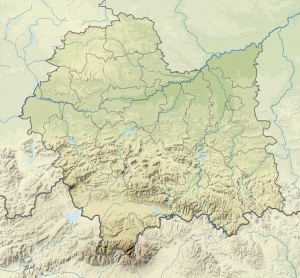Dziewulski Palace
| Dziekana Palace | ||
|---|---|---|
|
Front facade |
||
| Alternative name (s): | Lilpopów Palace | |
| Creation time : | 1910 | |
| Castle type : | palace | |
| Conservation status: | Reconstructed | |
| Place: | Warsaw | |
| Geographical location | 52 ° 13 '30 " N , 21 ° 1' 23" E | |
|
|
||
The Dziewulski Palace (Polish: Pałacyk Dziewulskich ) is a large city villa with a palatial appearance in Warsaw . The neo-renaissance building is located at Aleje Ujazdowskie 33/35 ( downtown district ) next to the United States Embassy building . It was built as a residence at the beginning of the 20th century and is now the seat of the Bulgarian embassy in Poland.
history
The property was acquired in 1909 by the lawyer and economist Stefan Dziewulski and his wife Antonina Maria, b. Natanson acquired. Dziewulski had the palace of Eugeniusz Lubomirski that stood here torn down. A new building was built in 1910 based on a design by Władysław Marconi . It was the last luxury residence to be built on the Al. Ujazdowskie was built. The asymmetrical building with echoes of the late Renaissance harmonized with the older residences in the area. The core of the listed building is the large vestibule with the staircase. From the front (towards the Al. Ujazdowskie) the palace appears graceful and shows an unexpected depth on its northern flank. At the front there are two different corner projections, the southern semicircular of which is provided with a portico- like substructure. The roof is bordered by a balustrade .
After Dziewulski's death, his five children inherited the building. As one of the few Warsaw palaces, it was not destroyed during the Second World War . In 1946 the heirs sold it to the diplomatic mission of Bulgaria, which is still based here today. The Bulgarian Cultural Institute (Polish: Bułgarski Instytut Kultury ) is located in the neighboring building . The approximately 4500 square meter property has a well-tended, park-like garden.
Views
References and comments
- ^ Stefan Dziewulski (1876–1941) was a Polish lawyer and economist
See also
literature
- Julius A. Chroscicki and Andrzej Rottermund, Architectural Atlas of Warsaw , 1st edition, Arkady, Warsaw 1978, p. 218
- Tadeusz S. Jaroszewski, Palaces and Residences in Warsaw , Interpress Publishing House, ISBN 83-223-2049-3 , Warsaw 1985, p. 37





